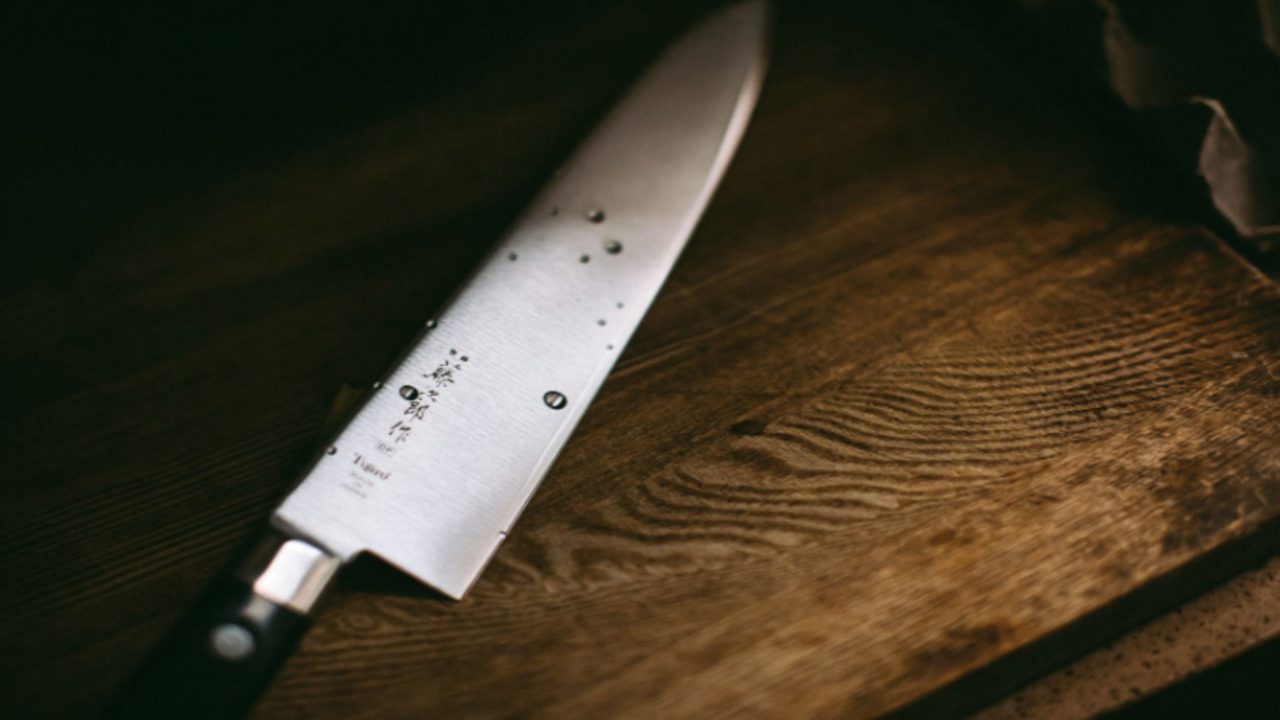In the culinary world, many different knives are used to cut, debone, mince, and shape different types of ingredients.
Present in professional and home kitchens, knives are essential tools for preparing meals, desserts, and cocktails.
Most culinary enthusiasts have not been trained in handling professional knives properly, but they learn by themselves from mistakes and success.
As a result, many are unaware of cutting techniques, which knives are suitable for specific tasks, ignore safety practices, and do not know how to maintain them properly.
Mastering all these techniques is essential for knife maintenance and your own safety.
“Remember, It is never knife’s fault
-Daniel Boulud – French chef and restaurateur
Jump to Section
- Knife Anatomy
- Knives Vs. Tasks: What Are The Basic Knives Needed?
- How To Choose A Knife?
- How To Care For And Maintain Your Knives
- 17 Safety Tips To Consider When Handling Knives
Knife Anatomy
Knives are forged or stamped from a piece of steel that goes the whole length of the knife.
As an indispensable tool, knives can vary in material, weight, shape, and size.
The knife’s blade is made of high carbon steel, stainless steel, titanium, and ceramic and varies in price and durability.
Take a ride now into the knife´s anatomy.
Knives Vs. Tasks: What Are The Basic Knives Needed?
Have you known that there is a specific knife for every task in the kitchen?
Knives are not manufactured in a single pattern but in different sizes, weights, and designs for various tasks, from chopping vegetables to carving meats and breaking down poultries to mincing garlic or ginger.
Basically, there are seven types of knives used in the kitchen.
7 Types of knives
- Chef Knife: Versatile and perfect for cutting, slicing, chopping, and also for cutting through dense meats, poultry bones, or breaking down thick root vegetables. The blade has a length ranging between 6 to 12 inches.
- Serrated or Bread knife: The serrated blade is used to cut bread crusts and sponge cakes that require a sawing movement. Sizes range from 8 to 10 inches.
- Slicing or Carving Knife: Its thin, narrow, and sharp-edged blade, usually between 8 to 15 inches, produces less resistance when cutting or carving meat from roasts, barbecues, hams, or poultry. It is also used for cutting cakes, as its blade is long enough to get perfect slices in one smooth motion.
- Fish fillet knife: Although It has a thin and flexible blade of 6 to 8 inches, it is easy to fillet flat and round fish.
- Deboning knife: With its 5-inch blade and a small tip, the deboning knife is precise to go between any meat or poultry joints.
- Paring knife: Although the blade is about 4 inches, this knife is versatile for peeling, trimming, carving, and sometimes boning small birds like quails.
- Butcher knife or Cleaver: It has a flat and rectangular blade, varying sizes depending on the intended use. The large, heavy design makes it easy to cut through bones and helps crush garlic and ginger or shape veal steaks and chicken breast in scaloppine. Some cleavers have a hole in the blade so they can be hung up when not in use.
How To Choose A Knife?
Like maintenance tools or instruments to a rock band, choose the knives according to the task and the one that best suits you.
According to experts, one of the most basic starting points is simply choosing what is comfortable and what you know.
In my opinion, the ideal knife for everyday life has to be of acceptable quality and, when holding it, it can offer a balance between weight and size with a good grip and, at the end of each task, your hands are not tired.
However, if it still feels weird and you don’t have a starting point, consider that there are different types of blades, sizes, and weights, which can impact a knife’s balance.
Understand now how each of these characteristics applies to the profile of the knives.
Blade Material
High-Carbon Steel
High carbon steel is comfortable to sharpen and has an unrivaled cut quality, but it is vulnerable to rust and stain and is expensive.
Stainless Steel
Stainless steel is a common household material. This type of steel does not have as sharp a blade as high-carbon steel but is rust-resistant and relatively inexpensive.
Ceramic
Ceramic knives can look like sophisticated plastic cutlery. Despite being more fragile than others, they are very light, having about half the weight of the steel blade, making them easier to handle.
Titanium
Titanium blades are sharp, comfortable, and relatively light but not ideal for cutting hard or dense ingredients.
Knife Size
An eight-inches chef’s knife will be ideal for a home cook as it has a light blade, making it comfortable to handle all kitchen tasks.
Small hands can use a six-inches, while the twelve-inches knife is ideal for those with large hands.
Knife Weight
The weight of a knife can influence balance. A heavy knife can be perfect for cutting dense meats, and poultry bones, or breaking up thick roots, while a lighter one is suitable for quickly chopping, mincing, and slicing ingredients.
But what is satisfyingly comfortable for one cook may be inconvenient for another. So, consider the ingredients you usually prepare daily in your kitchen to choose a knife with the ideal weight.
To find out if yours is an ideal weight, point the tip of the knife away from your body and then hold it in an upright position. Both positions should not require excessive effort to keep the blade straight, demonstrating that you have good weight and balance.
How To Care For And Maintain Your Knives
High-quality knives provide cutting and durability standards. As long as the maintenance and storage are correct, the blade will last a long time.
- Clean knives after using a soft sponge and dishwashing soap in lukewarm water. Dry carefully.
- Do not wash knives in the dishwasher. The high temperature of the machine can damage the handle and the blade.
- Protect the blade by storing it in knife blocks, magnetic holders, sheaths, or exceptional cases.
- Keep the blade of your knives always sharp to make cutting easier.
Sharpening a blade means removing a small amount of steel from its edge. How often you use a knife will determine how many times you need to sharpen it.
There are different pieces of equipment to keep knife blades sharp. The most used is the honing rod or steel, sharpening or whetting stones, and manual or electric sharpeners.
Honing rod: The honing rod is used to regularly realign the microscopic teeth of the blade, after sharpening it with an electric sharpener, for example. Sharpening the blade on the steel can be frequent and will maintain the knife’s sharpness for a certain period.
Electric Knife Sharpener: Sharpening a knife using an electric sharpener removes tiny amounts of steel from the blade due to the grind wheels’ abrasive action. This practice will sharpen the blade that will have to be kept later with the honing steel.
17 Safety Tips To Consider When Handling Knives
Bottom Line
Knives are essential tools in the kitchen. Therefore, finding out which one suits you best, understanding which knives are used for different activities, learning how to handle them skillfully and safely, and how to maintain them are basic rules that will give you safety when using them and the confidence to invest in a good value in a high-quality knife set.
Did you like this article?
I hope this article has helped you understand how to stay safe while handling chef knives. To learn more about kitchen safety, look at Safety Rules In The Kitchen: A Complete Guide.
Leave a comment below and share our content.
Please help our community grow by following our social media on Spotify, Instagram, Facebook, YouTube, and TikTok. And stay up to date with the news from the world of Gastronomy.
Don’t forget to tag @gastrovinoacademy on Instagram and hashtag it #gastrovinoacademy.
Cheers🍷


